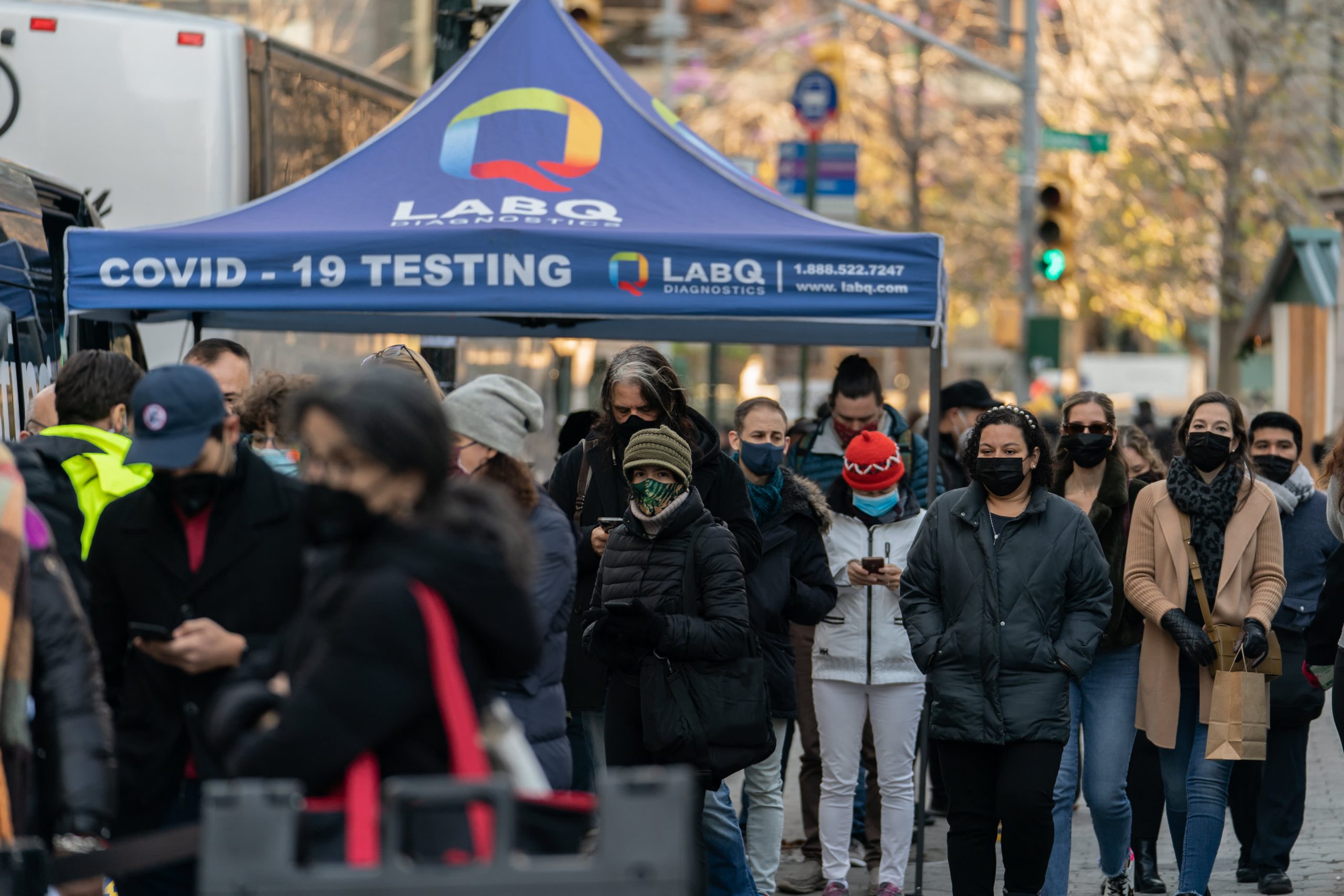
Pedestrians stand in line at a Covid-19 mobile testing site at Columbus Circle in New York, on Dec. 5, 2021.
Jeenah Moon/Bloomberg via Getty Images
Covid cases are spiking in some parts of the U.S., and the highly contagious omicron variant is expected to fuel another virus wave headed into winter.
In New York, some restaurants and Broadway performances closed temporarily this week. The positivity rate in the city doubled to 7.8% over three days, from Dec. 9 to 12.
Restaurants outside New York have had to shut their doors, too.
That same dynamic may soon affect a broader swath of Americans. Omicron is more contagious than the delta variant, and cases are doubling roughly every two days.
Workers who lose hours or their jobs may be wondering: Am I eligible for unemployment benefits?
For many, the answer is yes.
However, the U.S. unemployment system has ample nuances and complex rules, meaning the situation will vary by state and individual circumstance.
And some groups of workers who’d qualified for aid earlier in the pandemic may find that assistance is no longer available. Temporary federal programs that expanded the jobless safety net expired on Labor Day. Sick people who miss work or self-employed individuals who lose ample earnings, for example, are likely out of luck.
“It’s ultimately going to be up to the state workforce agency to determine if someone’s eligible,” said Michele Evermore, a senior policy advisor for unemployment insurance at the U.S. Labor Department.
The bottom line: Workers should apply if they think they may qualify, Evermore said. She advised workers be careful how they report data on their application. (One common and costly mistake, for example: reporting no earnings for the week since payday hasn’t yet come.)
Here’s what to know.
Partial benefits
Unemployment benefits are available in instances beyond a layoff; workers who lose significant hours may qualify, too.
Typically, workers need to lose at least half their weekly work to qualify in most states, according to Andrew Stettner, a senior fellow at The Century Foundation, a progressive think tank. So, a restaurant worker who loses two of four work shifts due to a temporary Covid shutdown may qualify.
These “partial” unemployment benefits are a portion of the full amount triggered by an outright job loss.
Rules around partial benefits (including amount and eligibility) vary by state.
Eligibility rules
There are many factors that influence your eligibility for benefits. Two primary determinants: earnings history and whether you have collected benefits during the past year.
Receiving state unemployment insurance starts a “benefit year.” This is a 52-week cycle during which you can collect a set amount of weekly benefits.
States determine the weekly amount based on your earnings history, typically over the last four or five full quarters of work.
Workers can generally get up to 26 total weeks of benefits during their benefit year; they can collect that total in fits and starts over multiple rounds of layoffs. (Amount and duration vary widely by state.)
For example, let’s say a worker collected $250 a week for 13 weeks over the spring and summer of 2021. This person can likely claim $250 a week for another 13 weeks if they lose their job heading into winter.
Someone who collected benefits earlier in the pandemic may have a harder time qualifying in the near future. They may have exhausted their maximum 26-week allotment and may need to wait until the clock resets to a new benefit year.
More from Personal Finance:
Americans should soon be able to get free at-home Covid tests
Credit card debt can get in the way of your retirement savings
Consumer watchdog takes aim at buy now, pay later programs
Even if a year has passed, they may not have earned enough since their last layoff to qualify for more assistance.
“The real question will be, did they work long enough when things opened back up?” Stettner said.
One exception may be “extended benefit” programs, additional weeks of benefits that become available during periods of high joblessness. Extended benefits were only available in four states (Alaska, Connecticut, New Jersey and New Mexico) as of Nov. 27, according to the Labor Department.
In some states, unemployed workers must also be searching for full-time work (and not a part-time job) to be eligible for benefits.
Omicron exposure
Some workers may need to stay home due to a Covid exposure or if they’re sick — and may lose pay as a result.
Workers who need to quarantine because they came in close contact with a person who tests positive may qualify for benefits, Evermore said. States may consider this person “able and available to work,” a key component of eligibility.
Perhaps counterintuitively, that likely wouldn’t be the case for someone who tests positive for Covid and can’t work, Evermore said.
“Unemployment insurance was never intended to be paid sick leave,” Evermore said. Workers may be able to get a paid-leave benefit from their employer or via a state program, she added.
Self-employed and gig workers
This wasn’t the case earlier in the pandemic. Congress had expanded the pool of workers eligible for unemployment benefits via the Pandemic Unemployment Assistance program, part of the CARES Act lawmakers passed in March 2020.
The PUA program offered federal benefits to those who missed work for a host of Covid-related reasons (contracting the virus or caring for a sick individual, for example). It also paid gig workers, the self-employed, independent contractors, freelancers and others who don’t generally qualify for state benefits.
That program lapsed on Labor Day, meaning many of these groups may no longer qualify. Some state labor agencies may determine gig workers and independent contractors to be eligible if they meet certain employment requirements, however, Evermore said.


 Signal2forex.com - Best Forex robots and signals
Signal2forex.com - Best Forex robots and signals




